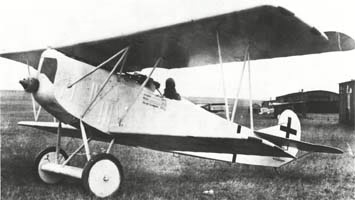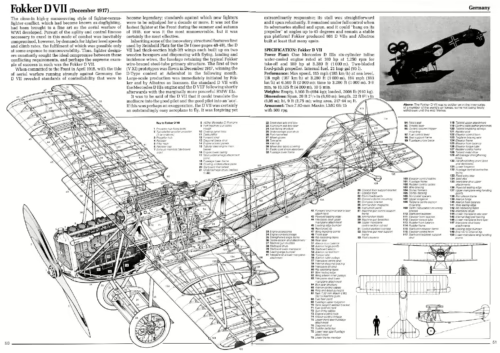Fokker D.VII History
The Fokker D.VII, widely claimed as the best German fighter of World War I, was evolved to a specification issued late in 1917. Its true prototype was the Fokker V.11, designed by Reinhold Platz. With thirty other machines, six of them alternative Fokker designs, the V.11 was tested at Adlershof in January/February 1918. It proved superior to all other entrants by a wide margin, and with modifications made at the instigation of Rittmeister von Richthofen, was immediately ordered for large-scale production: four hundred from Fokker, and substantial quantities from Albatros and O.A.W. The V.11 was somewhat unstable in a dive, and production D.Vlls therefore had a lengthened fuselage and a fixed vertical fin. There was an excellent view from the cockpit, and the D.VII was armed with twin 7.92 mm. Spandau guns with 500 r.p.g., immediately in front of the pilot. It was easy to fly, but its main advance over earlier German fighters was its ability to maintain performance at high altitude. This was enhanced even further from late summer 1918 by the D.VIIF, powered by a 185 h.p. B.M.W. IIIa. The D.VIIF was only fractionally faster than the D.VII, but had greater reserves of power above 5,000 m. (16,400 ft.), which height the D.VIIF could reach in 14 minutes, compared with the Mercedes D.Vll’s time of just over 38 minutes. Understandably, the D.VIIF was much sought after.
Von Richthofen’s Jagdgeschwader I (later commanded by Hermann Göring) began to receive the first Fokker D.Vlls in April 1918. Customary practice was to allocate new fighters to Jastas, and to pilots within Jastas, in order of eminence, and several months elapsed before some lesser Staffeln were able to get D. Vlls. Nevertheless, by the time of the Armistice, the Z.A.K. (Central Acceptance Commission) had accepted seven hundred and sixty D.Vlls, and the type had been delivered to forty-eight Jastas, although several units operated well below establishment. In all, Fokker built at least eight hundred and forty D.Vlls; seven hundred and eighty-five were ordered from Albatros, and nine hundred and seventy-five from the Ostdeutsche Albatros Werke. In Austro-Hungary, the type was built by M.A.G. as the Series 93; a second Series (132) was ordered from the Austrian Aviatik company, but none of the latter were built.
Throughout summer and autumn 1918, the Fokker D.Vll was treated with a respect afforded to no German fighter since the Fokker E.III three years earlier, and Article IV of the Armistice Agreement paid it a unique tribute by singling it out for specific mention among items of military equipment to be handed over to the Allies. This squashed Anthony Fokker’s hopes of continuing in the aircraft manufacturing business in Germany after the war, and precipitated the now-famous smuggling episode, in which he succeeded in getting four hundred engines and components of one hundred and twenty aircraft, most of them D.Vlls, out of Germany into Holland. The D.VII continued in production in Holland after the war, and remained in service, first with the Dutch Army Air Service and later in the Netherlands East Indies, until the late 1920s. Between 1919 and 1926, a number of ex-wartime D.VIIs were used, after conversion to 2-seaters, as trainers by the Belgian Aviation Militaire; twenty-seven were supplied to the Swiss Fliegertruppe.
Fokker D.VII Specifications
| Aircraft Type: |
| fighter |
| Dimensions: |
| wingspan: 29 ft, 2 in |
| length: 22 ft, 9 in |
| height: 9 ft |
| Weights: |
| empty: 1,477 lb |
| gross: 1,984 lb |
| Power plant: |
| 1 × 185 hp BMW IIIa liquid-cooled in-line engine |
| Performance: |
| maximum speed: 117 mph |
| ceiling: 19,685 ft |
| maximum range: 200 mi |
| Armament: |
| 2 × 7.62 mm calibre machine guns |
| Operational Use: |
| 1918–1926 |










